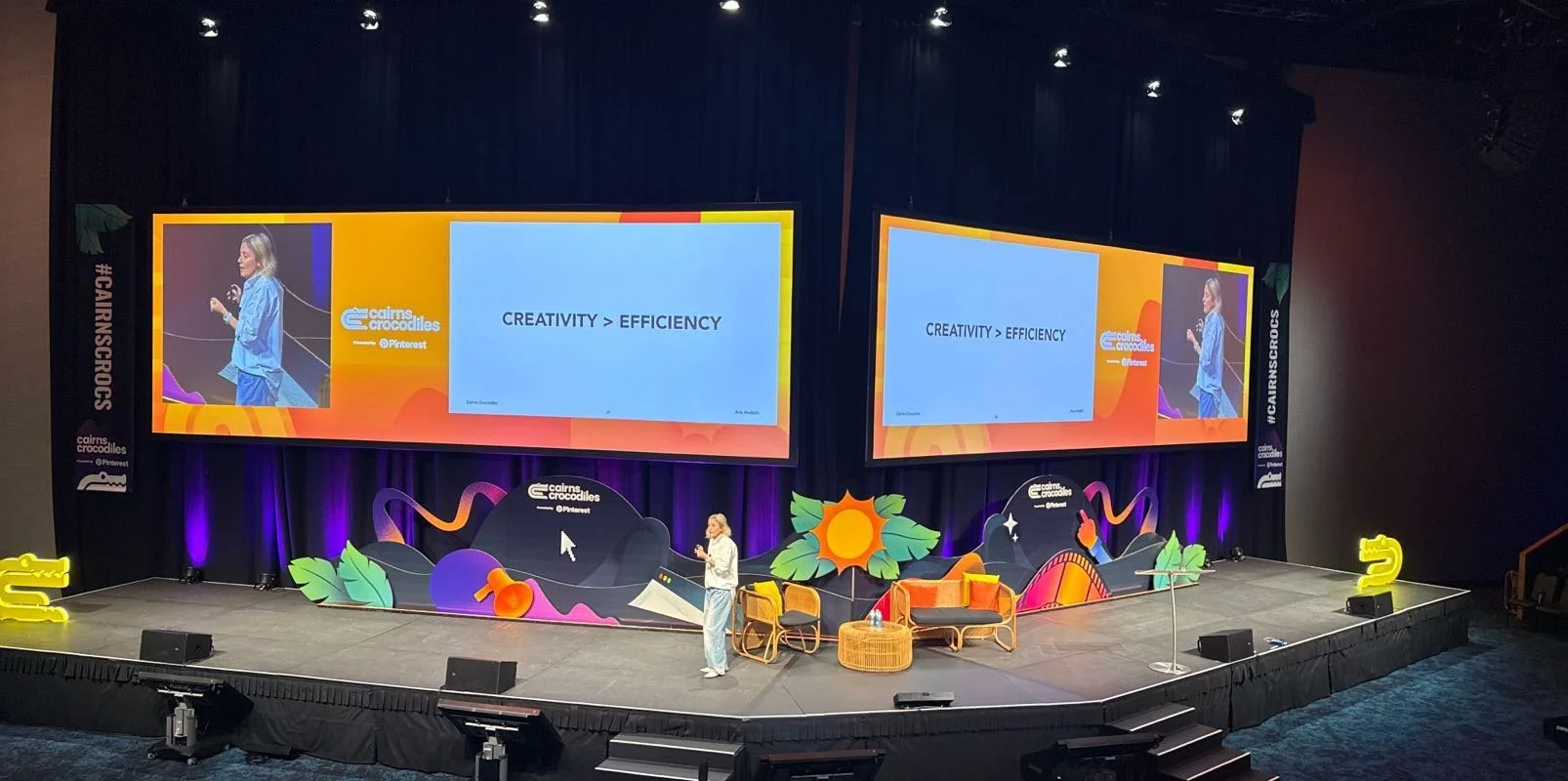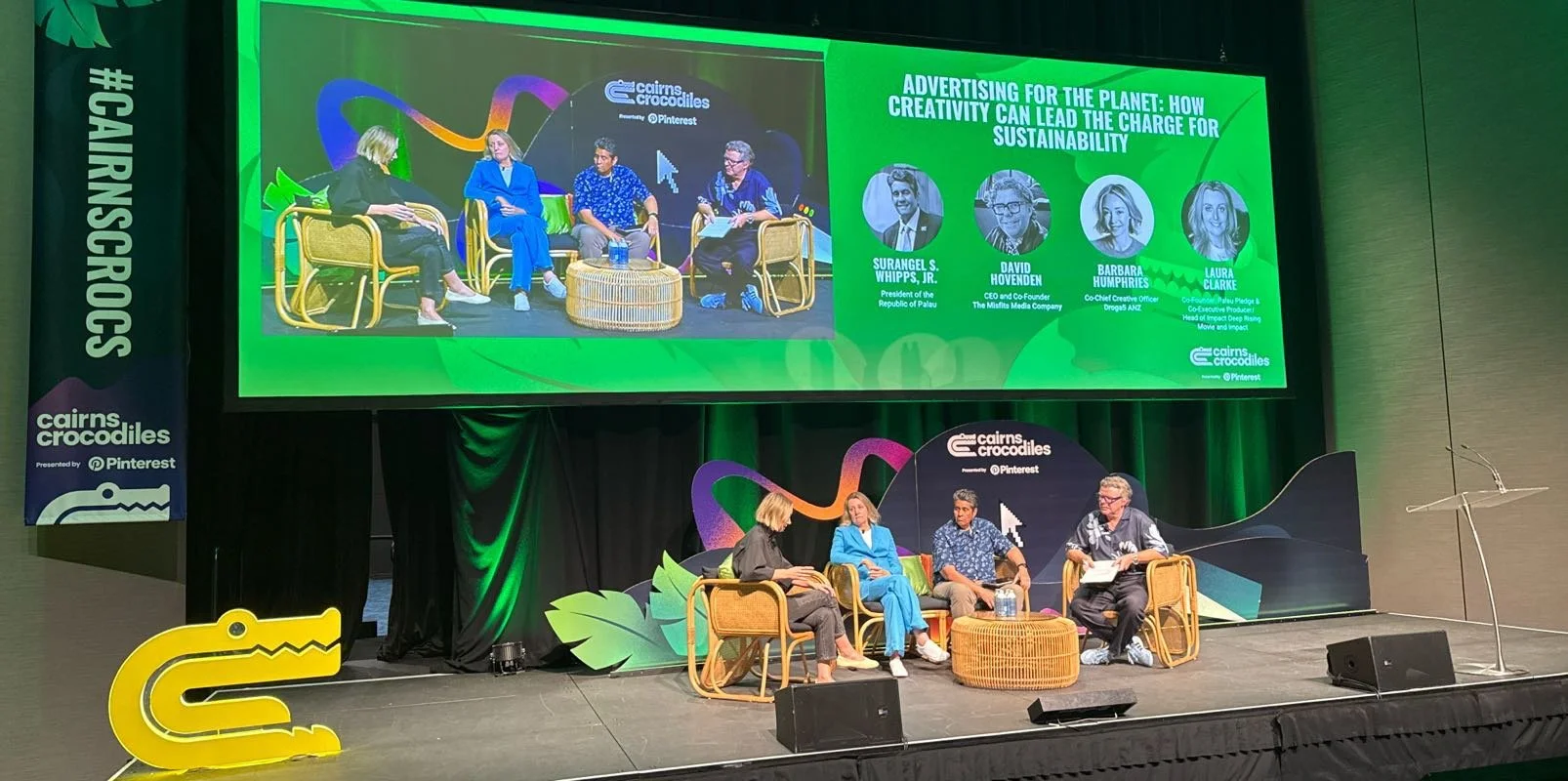Culture, Connection and Commercial Impact: Insights from Cairns Crocs 2025
First impressions
From 13 to 15 May, Cairns Crocs turns Far North Queensland into an ideas greenhouse for advertising, marketing and media. Three days of keynotes, masterclasses and the Crocs Awards unspool between two World-Heritage icons—the Daintree rainforest and the Great Barrier Reef—while the new Hatchlings program showcases the country’s most exciting emerging talent.
I’ve spent the first forty-eight hours darting between sessions and chairing the Hatchlings Design jury. (Those short-listed pieces are extraordinary; details once the trophies land tonight.) Production values, speaker calibre, hallway debate—everything feels world-class. If you’re weighing up a 2026 ticket, stop weighing.
The conversations share a through-line: the brand–audience relationship has tilted, and the winners are those treating that tilt as an operating principle, not a talking point. Five sessions (the ones I could get to) crystallised that shift.
1. Beyond ads: cultural products as currency
Ana Andjelic – “Hitmakers”
“Brands used to tell their stories through advertising. Now they tell them through cultural products.”
Andjelic’s thesis is blunt: Burberry’s trench, Ferrari’s runway collection, Stanley’s flame-proof tumbler—these aren’t line-extensions; they’re money-printing IP. She calls them celebrity products: artefacts that embed a story so deeply that customers treat purchases like fandom. Success, she argued, comes from portfolio logic: release ten bets into different sub-cultures, accept that a few will fail, and double-down when one catches fire.
Why the scatter-shot? Because mass monoculture is gone. Distinct communities—corecore, dark academia, motor-sport streetwear—have their own codes and gatekeepers. If a brand wants to matter, it has to play at community speed, not board-meeting speed. That, Andjelic warned, demands dismantling the classic “ideas” vs “commercialisation” silo. Her pragmatic fix: make the CMO and CFO best friends and spread accountability for hit-rate across both camps.
WHAT YOU CAN STEAL
Ring-fence budget for artefacts, not airtime—a zine drop, a micro-collab, a browser plug-in, anything fans will queue to post. Once people show it off unprompted, dial back paid reach and let word-of-mouth compound.
2. Authenticity beats “cool” every time
Xanthe Wells – Pinterest
Pinterest’s leap from “craft-mom mood-board” to Gen Z engine was less rebrand, more mindset swap. Wells’ team began by watching how twenty-somethings used the platform: not to plan events, but to curate aesthetics—cottage-core, dystopian sci-fi, sun-bleached techno—all in private boards free from comment snark.
“You can’t catch up with Gen Z,” Wells said. “They’re already ahead.”
The insight flipped Pinterest’s role: it became “the gallery walls, not the paintings,” elevating user creativity rather than performing coolness itself. Two utilities sealed the deal: Pinterest Predicts (trend forecasts now 80% accurate) and Pinterest Palette (its own annual colour range). Both give users tools to act, not corporate slogans to admire.
WHAT YOU CAN STEAL
Hunt the friction points where your product punishes experimentation—sign-up, checkout, public feedback loops. Add a sandbox or private preview; scrap anything that outs mistakes. Lowering the cost of self-expression outruns catch-phrase campaigns every time.
Advertising for the Planet Panel – Barbara Humphries, Laura Clarke, Surangel Whipps Jr. and David Hovenden
3. Purpose that survives hard questions
“Advertising for the Planet” – Palau Pledge & Tuvalu Digital Nation
The sustainability panel cut straight to the high stakes of their movement. Palau’s President Surangel Whipps Jr. framed purpose in generational terms:
“Inheritance here isn’t money; it’s the health of the land and ocean you leave your children.”
Creative strategist Laura Clarke unpacked the Palau Pledge—a simple passport stamp every tourist signs, committing to environmental care. Cost: negligible. Impact: behaviour change, global press and policy debate about deep-sea mining. Then came the line everyone copied into their notes:
“You can’t do this work to win awards—you have to actually give a damn.”
Clarke’s point landed because the panel also spotlighted Tuvalu’s daunting pivot to a digital nation, archiving land, culture and governance before rising seas erase its physical territory. Emotion powered attention; hard evidence powered policy.
WHAT YOU CAN STEAL
Run the internal-cost test—and apply it to your own agency first. If the cause you’re pitching doesn’t keep the creative team talking after hours or force a tough conversation with your finance lead, you’re browsing for trophies, not impact. Pick a commitment that stings a little (budget re-route, resource allocation, margin haircut) – when the pain is real, the credibility follows.
4. Small budgets, honest lessons
Bryan Wilmot – Stake | Kate Jarvis – Latrobe Health
The “Big Ideas, Tight Budgets” session offered practical wisdom for marketers working with constraints—which, let's face it, is all of us.
Bryan Wilmot, CMO of Stake, shared how he grew the company from 5,000 to 700,000 customers with an initial marketing budget of just $5,000 a month. His approach? Understanding that budget is “just a scale factor, not a strategy.”
When resources were limited, Wilmot focused on finding what worked on a small scale—like a referral program that now drives 30-40% of their acquisitions—before scaling up. Similarly, Kate Jarvis of Latrobe Health Service shared how her team leverages user-generated content to explain complex health insurance concepts authentically.
Both CMOs emphasised the importance of speaking the language of finance. “It's not brand versus performance,” Wilmot explained. “It's brand and performance and activation and customer lifecycle.” The key is identifying the right tool for each job to be done.
For marketers struggling to get internal buy-in, Jarvis offered this advice: “Tenure in your role... it takes time to develop trust, which is earned, not given.” She also emphasised the value of proving your worth through measurable outcomes while still making the case for creative campaigns that build brand.
WHAT YOU CAN STEAL
Start a “Shame & Learn” spreadsheet. Log every test, spend, result and takeaway. Circulate it company-wide. The doc turns cheap flops into future guard-rails and keeps experimentation heroic rather than haphazard.
5. Equity, alignment… and a few grenades
Henry Innis and Pippa Chambers
Henry Innis – Mutinex Unfiltered
The fireside chat lived up to its billing. First grenade:
“If your people don’t own a slice of the upside, you don’t have long-term alignment.”
Innis insists on equity or profit-share; anything else, he argues, is hoping for discretionary effort without a receipt.
Second grenade:
“The single biggest mistake in media today is buying on CPM. Procurement’s obsession trashes publisher value and pushes spend into unsafe inventory.”
He predicts principal media—agencies reselling inventory they buy themselves—will implode once clients tally the conflict. And on hyper-personalisation? “No statistical evidence it works.”
Long-term value, not quick exits, guides Mutinex’s roadmap: answer 500 000 marketer questions a year and the valuation will take care of itself.
WHAT YOU CAN STEAL
Retire CPM as a primary target. Replace it with incremental profit per customer, new-audience reach or any metric that maps directly to revenue. Then line-up every partner’s compensation against that number—clarity first, volume second.
The Rebellion perspective
Across these sessions the same threads weave:
Communities hold the keys. Whether cultural products, Pinterest boards or conservation pledges, the audience now writes chapter two of every brand story.
Creativity is commerce. When properly aimed, ideas move units, not just sentiment trackers.
Authenticity is the price of entry. Younger consumers filter veneer at Wi-Fi speed; only the tangible survives scrutiny.
Influence is shared, not hoarded. UGC, referral loops and open platforms spread risk and multiply reach.
Structures must match ambition. Equity schemes, outcome metrics and cross-department budgets signal seriousness.
Marketing’s job is shifting from message control to connection design. Brands prepared to enable rather than broadcast will write the next chapter. That’s the transformation we’re building at Rebellion Consulting—helping organisations move from incremental tweaks inside tired frameworks to value creation in a world where the audience is in charge.
Day 3 beckons. Crocs and Hatchlings winners land tonight, and a fresh slate of sessions promises more provocation. I’ll report back, same Crocs channel, caffeine in hand. Until then: pick a “steal”, run a test and remember—the river only looks calm until you see the crocodile.




